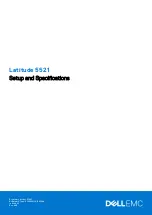
Your Network Connections
29
WEP 128 Bit – Shared
: This option provides security, but it’s relatively weak (but
stronger than
WEP 64 Bit – Shared
). This option works with older and newer Wi-Fi
devices, and is recommended only if any of your devices don’t support WPA or
WPA2.
Shared WEP uses the same key for encryption and authentication; some consider
shared WEP to be less secure than open WEP.
WPA PSK TKIP
: This is a strong security standard that is supported by most Wi-Fi
devices.
WPA2 PSK AES
: This is a stronger, newer security standard that is limited to newer
Wi-Fi devices.
WPA2 PSK TKIP
: This is a stronger, newer security standard that is limited to newer
Wi-Fi devices.
WPA/WPA2 Enterprise
(recommended setting if any of your devices are more than
two years old): Wi-Fi devices that use either WPA or WPA2 can connect to the
NETGEAR 6100D. Supported by most Wi-Fi devices.
6. Click
Submit
.
The option you select determines the Wi-Fi security used and also the maximum length of the
Wi-Fi password.
Change Wi-Fi Network Names and Passwords
The Main and Guest Wi-Fi network names identify your Wi-Fi networks and are visible to other
Wi-Fi-enabled devices.
You can change the names and passwords for your Main and Guest Wi-Fi networks on the
gateway’s
Wi-Fi > Options
page.
For optimal security, you should make your Wi-Fi network names and passwords unique, and
change them on a regular basis.
Note:
If you change either of the Wi-Fi network names or passwords, all connected devices will
be disconnected and will have to reconnect using the new values.
Note:
For security reasons, it’s recommended you disable SSID Broadcast. (See
Options
Section
.)
To make your Wi-Fi passwords more secure:
●
Use numbers and both uppercase and lowercase letters.
●
Use special characters (for example, ‘@’, ‘#’, etc.).
















































